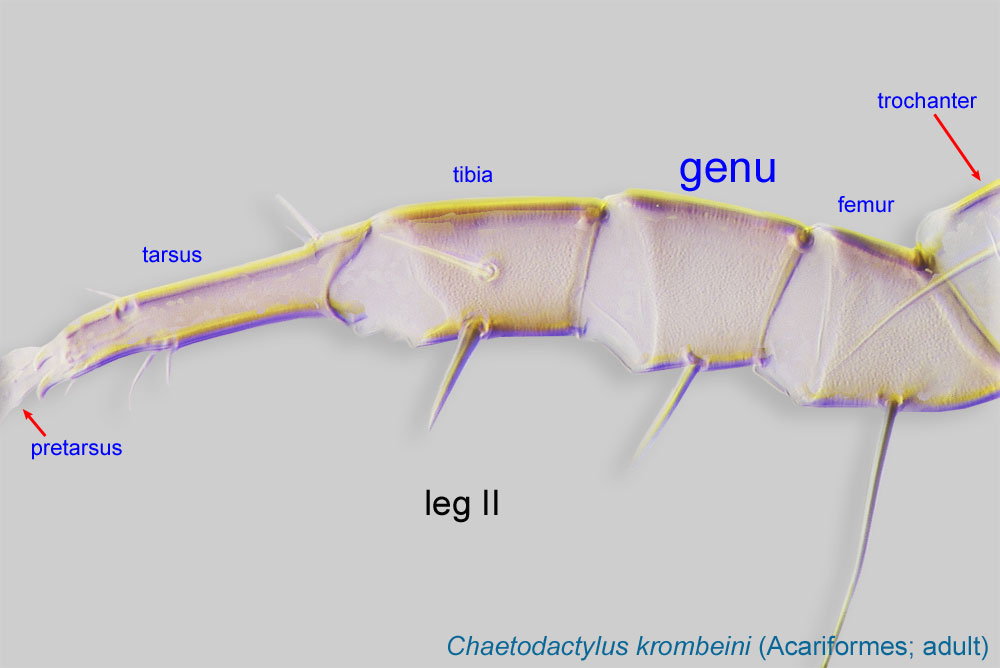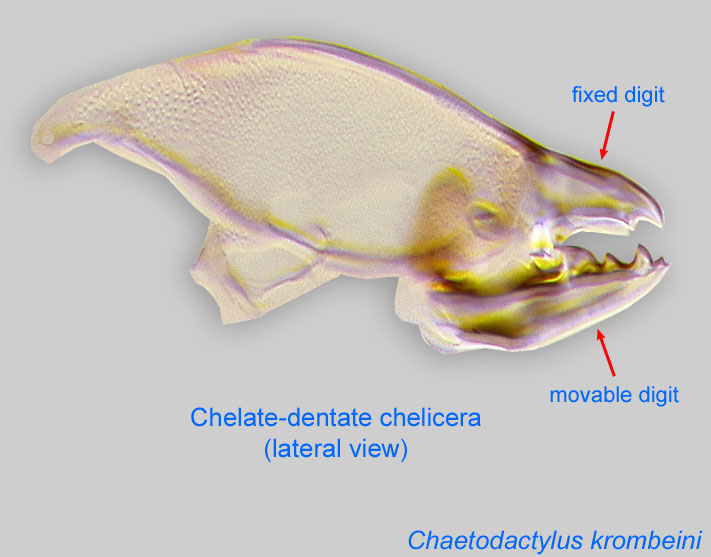mostly neutral; feeds on small arthropods in bee nests
Androlaelaps Berlese, 1903
Superorder Parasitiformes » Order Mesostigmata » Suborder Monogynaspida » Hyporder Dermanyssiae » Family Laelapidae » Genus Androlaelaps
Laelaps (Iphis) hermaphrodita Berlese, 1887
Adult: Genugenu:
Leg or palp segment (also known as podomere or palpomere) between tibia and femur.
 IV with 10 setae (posterolateral setae pl1 present) (Figs. 2, 7). Pilus dentilispilus dentilis:
IV with 10 setae (posterolateral setae pl1 present) (Figs. 2, 7). Pilus dentilispilus dentilis:
A seta-like or membranous sensory organ inserted ventrolaterally on the fixed digit of the chelicera of many Mesostigmata.
long and slender or inflated basally (Figs. 2, 8, 9,10). Chelicerachelicera:
Anterior, paired appendage of the body. Primary organ for food acquisition, adapted for chewing, piercing, tearing, sucking, or filtering.
 of male strongly modified, fixed and movable digits not chelate (Fig. 11).
of male strongly modified, fixed and movable digits not chelate (Fig. 11).
This is a large genus that needs a revision. Four species have been recorded from honey bees and bumble bees (see below) and other habitats. Three of these species can be identified using the key in Evans and Till, 1966Evans and Till, 1966:
Evans, G. O. amp; W. M. Till. 1966. Studies on the British Dermanyssidae (Acari: Mesostigmata) Part II. Classification. Bulletin of the British Museum (Natural History) Zoology. 14: 107-370., while to identify Androlaelaps bayoumi, the original description (Basha and Yousef, 2000Basha and Yousef, 2000:
Basha, A.-A. E. amp; A.-T. A. Yousef. 2000(2001). New species of Laelapidae and Ascidae from Egypt: Genera Androlaelaps and Blattisocius (Acari: Gamasida). Acarologia (Paris). 41: 395-402.) should be consulted.
Androlaelaps bayoumi Basha and Yousef, 2000Basha and Yousef, 2000:
Basha, A.-A. E. amp; A.-T. A. Yousef. 2000(2001). New species of Laelapidae and Ascidae from Egypt: Genera Androlaelaps and Blattisocius (Acari: Gamasida). Acarologia (Paris). 41: 395-402. [Apis]
Androlaelaps casalis (Berlese, 1887) [Apis]
Androlaelaps fahrenholzi (Berlese, 1911) [Apis]
Androlaelaps myrmecophila (Evans and Till, 1966Evans and Till, 1966:
Evans, G. O. amp; W. M. Till. 1966. Studies on the British Dermanyssidae (Acari: Mesostigmata) Part II. Classification. Bulletin of the British Museum (Natural History) Zoology. 14: 107-370.) [Bombus]
Holarctic region (species found in bee nests).
honey bees (Apis) and bumble bees (Bombus)
facultativefacultative:
can complete entire life cycle without bees or their close relative, wasps
Many species develop tight associations with their bird or mammal hosts. Four species have been recorded either from honey bees or bumble bees; they are probably all generalists that opportunistically invade bee nests.